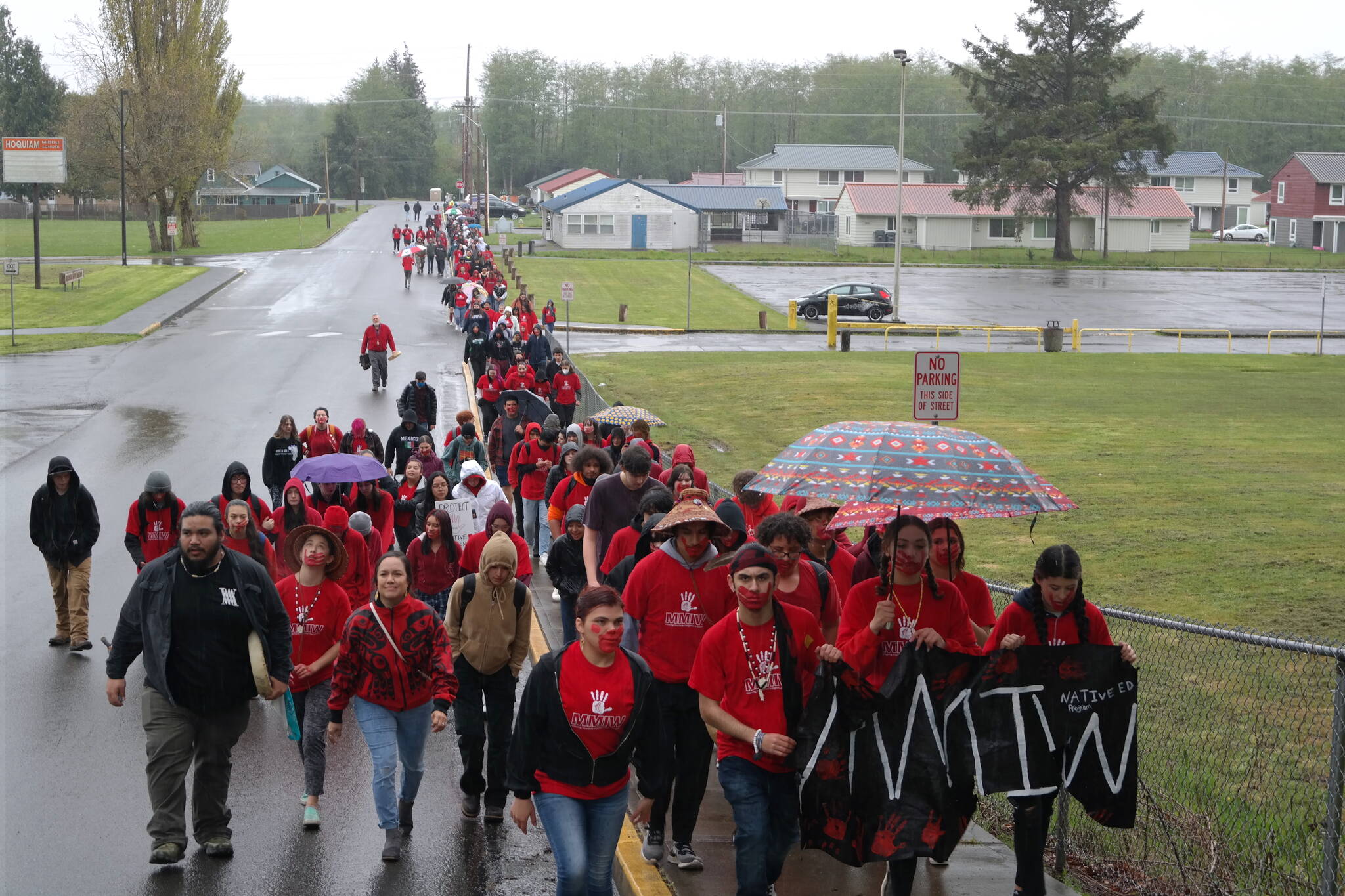As the rain poured down on the morning of Thursday, May 5, it seemed to match the internal rhythm of the day’s events — pairing with the march of over 150 students and the beat of a drum, leading a song in prayer for all the missing and murdered Indigenous women and girls (MMIWG).
“I think the Creator sent the rain to test our strength, and to show that we’re strong and we will still go out,” said Tyson Reece, a sophomore at Hoquiam High School (HHS) and a member of the Cherokee Tribe.
For Anthony Walkins, HHS junior and member of the Umatilla Tribe, he thought of the rain as the tears of all the MMIWG.
May 5 is the National Day of Awareness for MMIWG, and a group of students at HHS were determined to mark it here in Grays Harbor County.
“We weren’t expecting it to become as big as it did,” said Sandy Ruiz Greenway, who serves as Native Education Coordinator for the Hoquiam School District and has worked with Reece, Walkins, and their peers for three years.
“For our town, we haven’t done anything like that before to raise awareness. Representation hasn’t historically always been in the classroom, so this was an opportunity for these students to bring out the pride in their culture.”
It was in the room of the Native Education program that Ruiz Greenway and her students began planning an “awareness walk” to shed light on the epidemic of MMIWG that has often been overlooked. On Thursday morning, more than 150 students from the middle school and high school walked a loop from the HHS upper parking lot, down Spencer Street, and back.
Despite the rain and the hills, the group continued on, clad in matching red shirts and following the lead of their peers in the Native Education program.
“I want people to know what’s going on, because they don’t see what’s happening, they don’t see what Indigenous people face every day,” said Reece.
According to a report by the U.S. Department of Justice, in some counties Native American women are murdered at a rate more than 10 times the national average. Idigenous women are also at a higher risk for violence, with 84.3 percent of American Indian and Alaska Native women experiencing violence in their lifetime, according to the National Congress of American Indians.
While the plight of Native American women has not gained much traction outside of Indigenous communities, it is not an insular issue. More than 90 percent of American Indian and Alaska Native, women who are victims of sexual violence, experience that violence at the hands of a non-Native perpetrator.
Discrepancies between the response to the disappearance of Native women and white women were briefly brought to mainstream media attention in September 2021 when 22-year-old travel influencer Gabby Petito went missing while on a road trip with her boyfriend. After an extensive search by five agencies, including the FBI, Petito’s remains were found in Grand Teton National Park. Her death was ruled a homicide by strangulation.
According to a 2021 report from the University of Wyoming, 710 Idigenous people were reported missing in Wyoming in the past decade: 57 percent are women and girls. The report also found that Idigenous people were about 100 percent more likely than white people to still be missing after 30 days.
“I want America to see the distraught and anger on my face — the anger for the sisters, daughters, and mothers that won’t be coming back to us,” said Reece.
The students of the Native Education program worked hard to mobilize their non-Idigenous peers to join Thursday’s awareness walk and learn more about MMIW, but the work is not done.
“I feel like we should take pride in what we did today, but never be satisfied,” said HHS sophomore Omar Estrada. Estrada is a member of the Capoeman family of the Quinault Tribe.
The group has already pledged to bring the MMIW awareness walk back next year, and to create a space where more Indigenous students feel comfortable in joining and speaking out.
“We shouldn’t have to have this walk, but we do,” said Reece. “It’s important for this town to see Native kids coming together, brown kids coming together. We’re strong, as Indigenous people we’re strong.”



